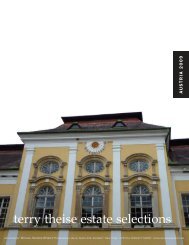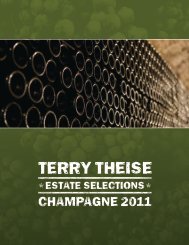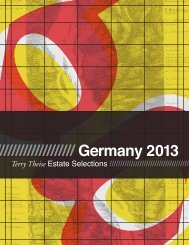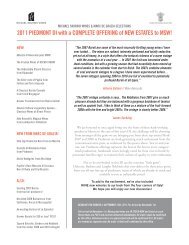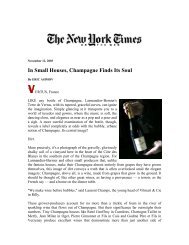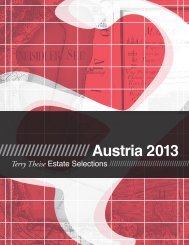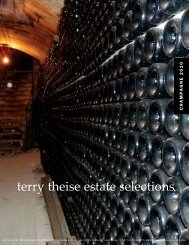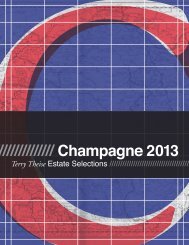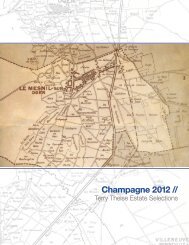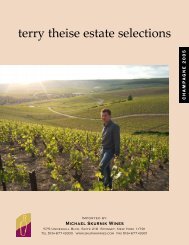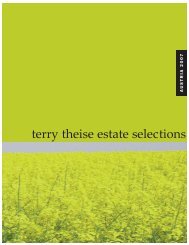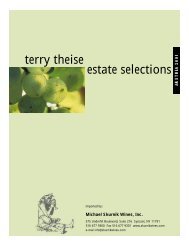German Catalog 2006 USE THIS ONE.qxp - Michael Skurnik Wines
German Catalog 2006 USE THIS ONE.qxp - Michael Skurnik Wines
German Catalog 2006 USE THIS ONE.qxp - Michael Skurnik Wines
Create successful ePaper yourself
Turn your PDF publications into a flip-book with our unique Google optimized e-Paper software.
MOSEL WINES<br />
70<br />
a.j. adam<br />
mosel • dhron<br />
You want a garagiste? Here’s a garagiste! The guy makes about 600 cases of frickin unbelievable<br />
wine in his spare-time from Grand Cru vineyards.<br />
It took me (too) many years to learn there’d never be enough time to have the kind of<br />
soul-searching conversations about wine philosophy I wanted to have with my growers. Also,<br />
that such conversations couldn’t be contrived, but needed to happen spontaneously. Yet I wanted<br />
to know what made a grower tick, and so I created a little questionnaire which I leave behind<br />
for the grower to answer at his/her leisure. The results go into my catalog text, augmented by bon<br />
mots which actually do arise in conversation.<br />
Andreas Adam is an intense young man, and meeting<br />
him for the first time it was subdued by his old-world<br />
politeness. But answering my written questions in solitude<br />
seems to have unleashed the beast. Adam is both his<br />
own man — very much so — yet also emblematic of the<br />
new wave in <strong>German</strong> wine-think. I don’t agree with<br />
everything he espouses, but his bedrock passion is stirring.<br />
I think of that instant of ignition when I tasted my<br />
first Adam wine, and it all starts to make sense.<br />
Here’s some of what he wrote:<br />
“The hardest work of vinifying a great wine takes<br />
about nine months, from February till the beginning of<br />
November — rather like a pregnancy — during which<br />
time we let what happens happen, without disturbing or<br />
perturbing nature,<br />
but rather we watch<br />
over and work in<br />
harmony with<br />
nature’s larger<br />
power.<br />
“An aside: I’m<br />
sitting here writing<br />
on our terrace under<br />
a blue sky. Nearby<br />
sits a fallow vineyard,<br />
to which a vintner<br />
is carrying chemical<br />
fertilizer. . . .<br />
“I renounce any<br />
and all such treatments.<br />
I sustain my<br />
vineyards by intensive<br />
soil-work (I was<br />
ploughing this<br />
Andreas Adam<br />
morning; it smells so<br />
wonderfully of fresh<br />
earth and slate) to bring the essential nutrients up from<br />
the primary rock, the natural compost of a vineyard. This<br />
completion of the bond between the elemental soil and<br />
the work of the vintner is another piece in the puzzle of<br />
terroir. “<br />
Well-said!<br />
•Vineyard area: 1 hectares<br />
•Annual production: under 500 cases<br />
•Top sites: Dronerhofberg<br />
•Soil types: Weathered slate with clay<br />
•Grape varieties: 100% Riesling<br />
I then ask the grower, which is his peak-site. And<br />
why; is his choice due to specific terroir/microclimactic<br />
factors, or other circumstances such as vine-age or vinematerial?<br />
“We love our Dhronhofberger, in its lovely quiet<br />
side-valley, which leaves stress behind and is out of the<br />
stream of all which is trendy in <strong>German</strong> wine-growing;<br />
today Cabernet, tomorrow Sauvignon Blanc.<br />
What makes the vineyard great is of course its flavors;<br />
even young it often shows a striking exotic fruit,<br />
subtle spice, wild slate aromas and a finesse of acidity.”<br />
I agree. The only reason this site isn’t front-and-center<br />
among Mosel Grand Crus is the lack of a flagshipestate<br />
— until now. Hofberger is one of those Mosel sites<br />
with complex slate, in this case with a vein of clay and<br />
with a measure of the sandy slate-variant of the Nahe. It<br />
is both archetypal Mosel yet also extra-Mosel; it sometimes<br />
makes me think of Dönnhoff’s Brücke.<br />
Next I ask about terroir. Of course! Not for nothing<br />
have I been anointed terroir-lama. My question is specific:<br />
do you believe that components in your soil create flavors<br />
in your wines?<br />
“I think in <strong>German</strong>y we see terroir as a unity of<br />
grape, climate, soil, and the mentality of the person who<br />
works the vineyard. But the essence of that mentality is a<br />
knowledge that the geology of his terrain indeed creates<br />
the flavors in the grapes which grow there. Thus if you<br />
consider Riesling from blue-gray slate from the<br />
Goldtröpfchen, in its youth it’s herbacious, with delicate<br />
lime fragrance and mineral-salty on the palate. Contrast



